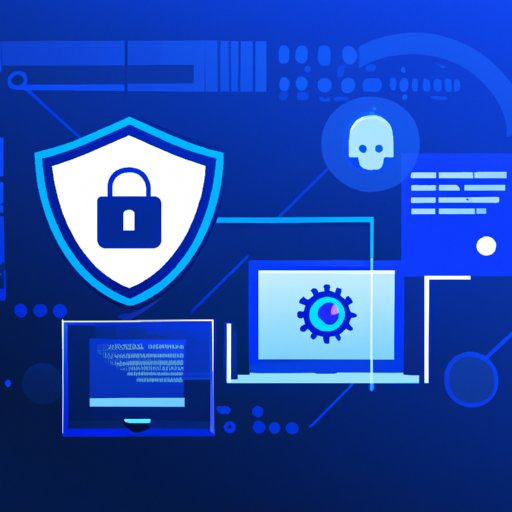Introduction
In today’s digital world, protecting an organization’s data is essential for success. Cybersecurity is the practice of protecting networks, systems, and programs from digital attacks. These attacks are usually aimed at accessing, changing, or destroying sensitive information, extorting money from users, or interrupting normal business processes. To ensure that an organization’s data is secure, a comprehensive cybersecurity program must be implemented.
Definition of Cybersecurity
Cybersecurity is the practice of defending computers, networks, programs, and data from malicious attacks. It includes the prevention of unauthorized access, disruption, or modification of data. It also involves the development and implementation of policies, procedures, and technologies to protect networks and systems from attack.
Overview of the Problem
Organizations face numerous threats in the digital world. These threats can come from a variety of sources, including malicious hackers, organized crime groups, nation-states, and even disgruntled employees. These threats can have a major impact on an organization, resulting in data breaches, financial losses, reputational damage, and more. It is therefore essential that organizations take steps to protect their data and systems.
Outline the Goals of the Cybersecurity Program
The goal of a cybersecurity program is to ensure that an organization’s data and systems are secure. To achieve this goal, the program should have the following components:
Identify and Protect Critical Data
The first step in any cybersecurity program is to identify and protect critical data. This includes identifying the types of data that need to be protected, as well as where it is stored and who has access to it. Once this has been determined, measures should be taken to ensure that the data is kept secure.
Define Security Controls
Security controls are the policies, processes, and technologies that are used to protect an organization’s data and systems. They include things like user authentication, encryption, patch management, and more. It is important that these controls are clearly defined and consistently enforced.
Establish Accountability
It is important that everyone in the organization understands their role in protecting the organization’s data and systems. This means that each person should understand what is expected of them and be held accountable for their actions. This could include regular training sessions, as well as periodic reviews and audits.
Ensure Regulatory Compliance
Organizations may be subject to various laws and regulations that require them to take certain steps to protect their data and systems. It is important that the cybersecurity program is designed to meet these requirements and that the organization is able to demonstrate compliance.

Identify Potential Threats and Vulnerabilities
Once the goals of the cybersecurity program have been outlined, the next step is to identify potential threats and vulnerabilities. This includes both internal and external threats. Internal threats are those that originate within the organization, such as negligent or malicious employees. External threats are those that come from outside the organization, such as hackers or malware.
Establish Policies and Procedures
Once the potential threats and vulnerabilities have been identified, the next step is to establish policies and procedures that will help to mitigate them. This could include creating an acceptable use policy, developing access control policies, and establishing incident response procedures.
Implement Security Solutions
Once the policies and procedures have been established, the next step is to implement security solutions. This could include things like firewalls, antivirus software, and intrusion detection systems. These solutions should be monitored and updated regularly to ensure they remain effective.

Monitor and Test the System Regularly
To ensure that the cybersecurity program is working as intended, it is important to monitor and test the system on a regular basis. This could include conducting periodic audits, performing penetration testing, and running vulnerability scans. This will help to identify any weaknesses that need to be addressed.

Educate Employees on Cybersecurity Best Practices
Finally, it is important to educate employees on cybersecurity best practices. This could include providing training on topics such as password security, phishing scams, and social engineering. It is also important to promote awareness of the importance of cybersecurity and encourage employees to report any suspicious activity.
Conclusion
A comprehensive cybersecurity program is essential for ensuring that an organization’s data and systems are secure. The program should include the identification and protection of critical data, the definition of security controls, the establishment of accountability, and the implementation of security solutions. It should also include the monitoring and testing of the system, as well as the education of employees on cybersecurity best practices.
Summary
A comprehensive cybersecurity program is essential for protecting an organization’s data and systems. It should include the identification and protection of critical data, the definition of security controls, the establishment of accountability, the implementation of security solutions, the monitoring and testing of the system, and the education of employees on best practices.
Final Thoughts
Cybersecurity is an ever-evolving field and it is important that organizations stay up to date with the latest threats and technologies. By implementing a comprehensive cybersecurity program, organizations can ensure that their data and systems are secure and that they remain compliant with applicable laws and regulations.
(Note: Is this article not meeting your expectations? Do you have knowledge or insights to share? Unlock new opportunities and expand your reach by joining our authors team. Click Registration to join us and share your expertise with our readers.)
